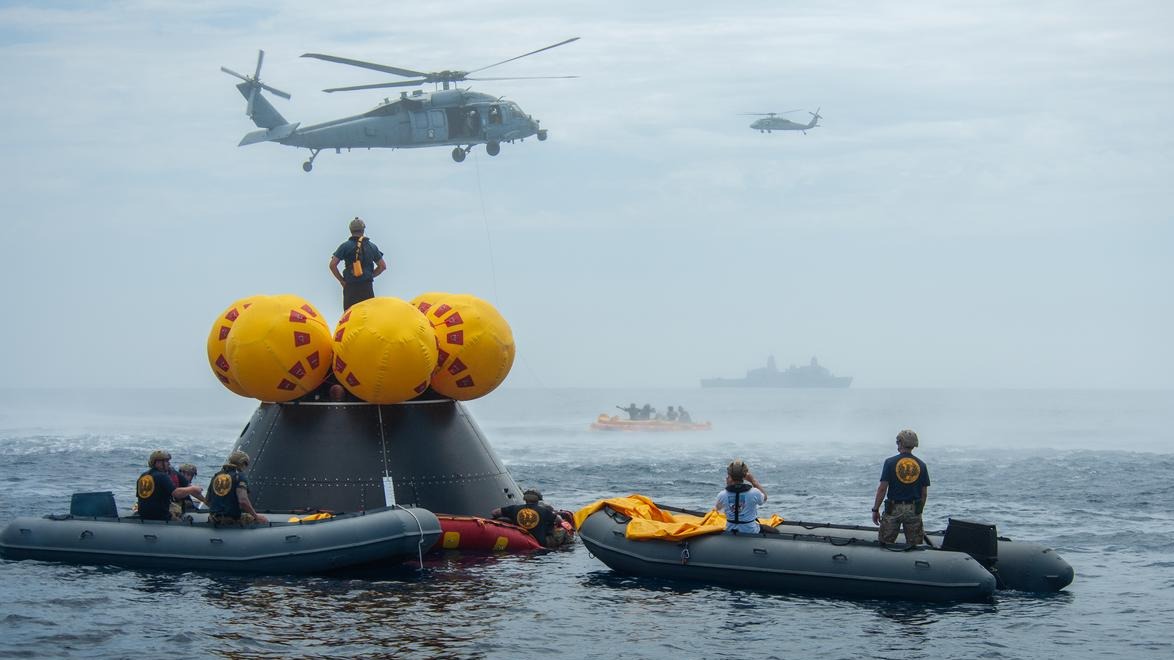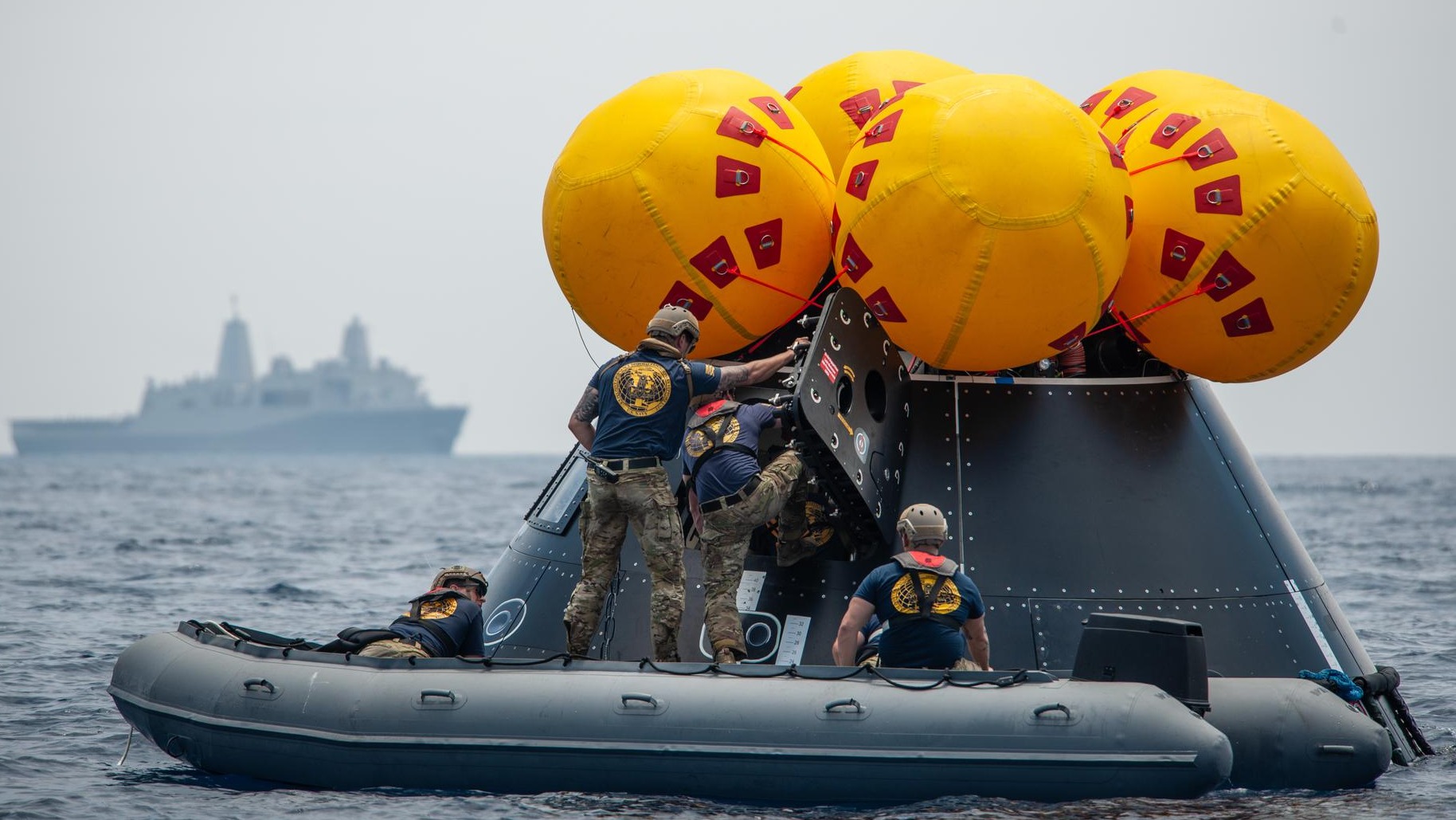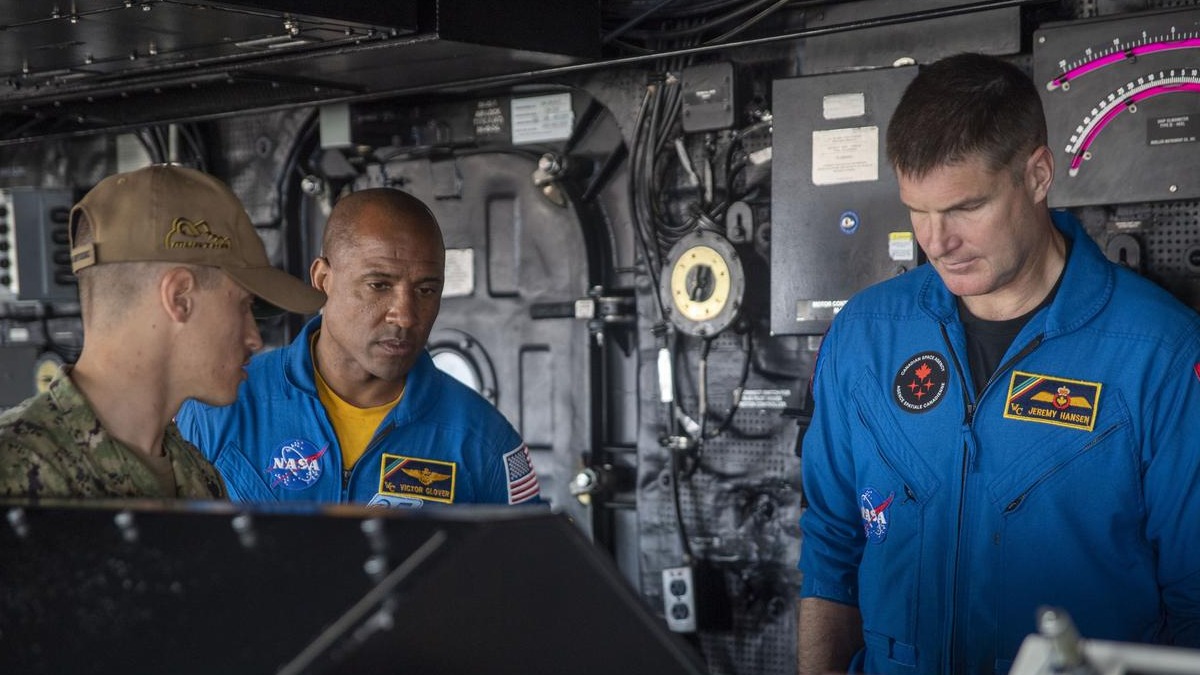Artemis 2 moon mission practice recovered crew from an Orion spacecraft at sea

The first dress rehearsal for a moon crew's landing is in the bag.
NASA and the U.S. Navy together practiced in the ocean near San Diego to help the Artemis 2 crew after their flight around the moon in November 2024. Four people, standing in as the astronauts, were safely extracted from a simulated spacecraft to get ready for the real splashdown next year.
The exercise wrapped up on Aug. 1 and NASA is now reviewing the results for the next go-round in February 2024, alongside the astronauts. While the Artemis 2 crew were not directly working on recovery this time, they did meet with team members to start forging connections and team-building for their round-the-moon mission.
"It's all very important," Lisa Seiler, NASA's Artemis landing and recovery deputy director, told Space.com. While numerous recovery exercises are taking place, the one in late July and early August focused on recovering four people from the spacecraft and getting them to a nearby ship's medical bay in less than two hours.
Both daytime and nighttime exercises met the mark with room to spare, despite some mechanical trouble with helicopters tasked with ferrying the crew members from spaceship to warship, Seiler said. "We did very well," she added, but much more practice will come between now and the launch.
Related: See Artemis 2 moon astronauts train with US Navy for Orion splashdown (photos, video)
The U.S. Navy — which supplied the helicopters, the U.S.S. John P. Murtha warship and key personnel — has a deep relationship with NASA extending to the earliest days of crewed missions. Years of NASA missions required splashdowns, including the Apollo program that brought nine crews to the moon's realm between 1968 and 1972.
Breaking space news, the latest updates on rocket launches, skywatching events and more!
The runway-landing space shuttle (which flew between 1981 and 2011) and subsequent use of steppe-hopping Russian Soyuz spacecraft then brought a hiatus to splashdown operations until a new generation of U.S. spacecraft came on board. Among them is the moonbound Orion spacecraft, which will end its mission in the ocean.
Years of tabletop exercises, work in the pool at the Neutral Buoyancy Laboratory at NASA's Johnson Space Center, and other activities culminated in this dramatic recovery exercise involving helicopters, ships, sailors and huge numbers of personnel in the Pacific Ocean.
Related: How Artemis 2 astronauts are training for their 2024 moon mission
"It's basically a crawl, walk, run approach," Seiler said, emphasizing the recovery crews go through many iterations of splashdown exercises before hitting the open water. Even the 10 days in the ocean involved on-the-scene training, with the dramatic practice recoveries taking place on days 5 (in day) and 7 (at night).
Just like after Artemis 2 concludes, the teams successfully opened the hatch on a floating Orion-like spacecraft, retrieved four people from inside and placed them atop a floating inflatable raft nicknamed "the front porch." From there, a helicopter scooped up the pretend "astronauts" (stand-in Navy pilots), one by one, and ferried them to the waiting warship and its staffed medical bay.
The Artemis 2 crew will participate in a single recovery exercise in February 2024, as mission rules dictate they need to restrict risky activities within six months of their November 2024 launch. It will basically be a repeat exercise, with day and night operations, to refine the procedures.
The last major recovery practice will take place roughly two months before the launch as a certification exercise to ready for the mission. If the launch delays beyond November 2024, the certification will also delay beyond its tentative spot that September.

During Artemis 2 recovery simulations, helicopters from the U.S. Navy's Helicopter Sea Combat Squadron 23 "Wildcards" fly over a simulated spacecraft known as the Orion Crew Module Test Article on July 29, 2023. The exercise with the U.S. military and NASA took place off the coast of San Diego.

A U.S. Navy helicopter from Helicopter Sea Combat Squadron 23 "Wildcards" practices scooping up people during Artemis 2 recovery exercises on July 29, 2023. NASA, the U.S. Navy and the U.S. Air Force all participated.

U.S. Navy divers enter a simulated Artemis 2 spacecraft, called the Orion Crew Module Test Article, during practice recovery operations on July 28, 2023. Here they are pretending to recover astronauts and lift them on to an inflatable "front porch" for extraction to a waiting helicopter. Their destination, the U.S.S. John P. Murtha warship, is visible in the background.

An Artemis 2 splashdown exercise on July 27, 2023 saw divers from the U.S. Navy securing a simulated spacecraft, called the Orion Crew Module Test Article, in the Pacific Ocean. The divers were with the explosive ordnance disposal expeditionary support unit and are trained to work on the open water, in small boats. Their goal will be to help the Artemis 2 astronauts safely leave the spacecraft after the moon crew splashes down.

Four Naval helicopter pilots, who were not identified in this picture, stood in as the four crew members of Artemis 2 during a splashdown exercise on July 29, 2023. Like the astronauts, the pilots were brought from the capsule onto an inflatable "front porch" and then lifted into a helicopter for a journey to the flight deck of the U.S.S. John P. Murtha warship.

A simulated Artemis 2 spacecraft, known as the Orion Crew Module Test Article, approaches the U.S.S. John P. Murtha warship during practice recovery operations on July 27, 2023.

During an Artemis 2 splashdown exercise on July 26, a simulated spacecraft known as the Orion Crew Module Test Article is visible at the U.S.S. John P. Murtha warship in the Pacific Ocean. NASA and the U.S. Navy worked together to practice recovery operations for the moon mission scheduled for late 2024.
All recovery exercises will use different warships and crews, both to have backup and also because the availability of ships will depend on where crews are deployed when Artemis 2 splashes down, Seiler said. The U.S. Navy will assign their warships and crews where operational needs are, closer to the date.
Recovery teams and crew will meet up several times in between these large exercises to continue team-building and getting to know each other and the procedures, Seiler added. "I think it is very important for them (the crew) to talk with who's going to be working with them. And I think we've already developed great rapport," she said.
Artemis 2 will be the second of the Artemis program series, following the uncrewed Artemis 1 that swung around the moon in late 2022. Next up will be the moon-landing effort of Artemis 3, set to touch down in 2025 or 2026 pending readiness of the SpaceX Starship lander tasked with bringing them to the surface.
The four crew members aboard Artemis 2 are NASA astronauts Reid Wiseman, Victor Glover and Christina Koch and Canadian Space Agency astronaut Jeremy Hansen. Canada's contribution to the NASA-led Artemis Accords for moon and peaceful space exploration includes Canadarm3, a robotic arm that will service NASA's future moon Gateway space station. Hansen's seat is part of the exchange of astronaut time and science agreed upon for Canada's tech work.

Elizabeth Howell (she/her), Ph.D., was a staff writer in the spaceflight channel between 2022 and 2024 specializing in Canadian space news. She was contributing writer for Space.com for 10 years from 2012 to 2024. Elizabeth's reporting includes multiple exclusives with the White House, leading world coverage about a lost-and-found space tomato on the International Space Station, witnessing five human spaceflight launches on two continents, flying parabolic, working inside a spacesuit, and participating in a simulated Mars mission. Her latest book, "Why Am I Taller?" (ECW Press, 2022) is co-written with astronaut Dave Williams.

